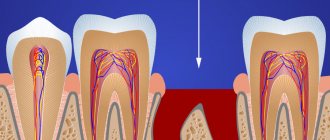Formally, from the point of view of classification, wisdom teeth (“eights”) are the same molars (large molars) used for chewing and grinding food. However, in fact, for a number of reasons, these teeth have a special attitude: both among dentists and their patients.
The reason for this attitude lies in several points:
- Rudimentary. Science has proven that the outer molars in the mouth are the legacy of very distant ancestors, whose jaw was much larger; the current “wisdom teeth” fit on it without problems and were functionally very important for primitive man. Currently, their value has decreased to almost zero.
- Late eruption. In modern humans, wisdom teeth appear in adulthood (from 17 to 25 years), when bone tissue is already formed. Moreover, they do not replace dairy products, but grow for the first time. As a result, the pain is much stronger than usual, and in search of “its place” on the jaw, an erupting wisdom tooth can lead to rupture of soft tissues, the risk of infection and even more serious consequences, including malocclusion and disease of neighboring teeth.
- Difficult to reach position. Wisdom teeth occupy an extreme position in the dentition, which makes it difficult to properly clean them and, in case of illness, to treat them.
Signs of alveolitis
The following symptoms indicate alveolitis of the socket:
- Socket pain that continues or renews on the 3-5th day after tooth extraction. In an uncomplicated postoperative period, it resolves in 1-2 days. At the beginning of the disease it is aching and becomes more intense after eating. At a later stage, the pain is constant and cannot be tolerated; painkillers help for a short time. It can radiate into the ear, into the temple on the side of the sore hole.
- The appearance of a bitter taste and putrid odor from the mouth.
- Enlargement and tenderness of the submandibular lymph nodes.
Upon examination, when alveolitis has just begun, the dentist discovers:
- redness of the gums,
- contents in the form of remains of a loose blood clot, food particles, saliva in the wound,
- that the hole is “dry”;
- in the midst of inflammation:
- swollen red mucous membrane along the edges of the hole,
- soreness when touched,
- there is a gray or yellowish coating on the walls.
Headache due to complications arising after dental intervention
Many patients experience headaches after visiting the dentist. Various factors can contribute to the appearance of pain symptoms:
- The appearance of complications that manifested themselves during dental treatment;
- Intolerance and allergic reactions to the use of drugs;
- Contraindications to tooth extraction;
- The appearance of a specific odor in the place of dental treatment;
- The presence of inflammation of the tissues of the oral cavity;
- The presence of swelling of the oral tissues;
Most often, pain occurs in several places. They begin in the jaw and gradually spread throughout the head. Painful sensations can be either sharp or aching. Complications after going to the dentist may depend on the presence of certain diseases in the patient:
- Very often, pain appears in patients suffering from diabetes. The headache may last for a long time;
- Ear disease, which can progress during dental treatment and cause headaches;
- Delay in contacting a specialist, which results in severe diseases of the teeth and gums, which are accompanied by painful symptoms of the head;
After symptoms of complications occur, you must go to the hospital to prescribe effective treatment. The occurrence of headaches may be due to the progression of certain dental diseases. Such as:
- Periodontitis – aching pain occurs in the temporal parts of the head;
- Alveolitis - severe pain occurs that begins in the jaw area;
Causes of alveolitis
Normally, after a tooth is removed, a clot of blood cells and fibrin, the protein from which a blood clot is built, forms in the socket. It almost completely covers the bottom and walls of the alveoli. The clot serves as a mechanical barrier, biological protection against infection and additional injury to the wound surface. In this case, healing occurs by primary intention. The wound is slowly filled first with loose tissue, then with denser connective tissue, and later with young bone.
But there are situations when the healing process is disrupted.
Inflammation of the socket occurs if:
1. The operation was highly traumatic, which reduced the protective capabilities of one’s own tissues;
2. The blood clot, as the main defense, is broken or completely absent (“dry socket”):
- prolonged bleeding;
- early destruction of the clot;
- non-compliance with the rules of care (for example, increased rinsing, eating hard or too hot food soon after surgery);
3. Tooth extraction was carried out for emergency reasons due to an acute infectious process: periodontitis or periodontitis with complications;
4. There are common reasons:
- reduced immunity;
- blood clotting disorder;
- elderly age;
- lack of proper dental hygiene.
Headaches after using anesthesia
Very often, dentists use local anesthesia when treating teeth. After undergoing anesthesia, many patients experience headaches. There are several reasons for this type of pain:
- Presence of intolerance to anesthesia or incorrect choice of medication;
- Location of the diseased tooth in remote places;
Most often, the headache is aching in nature and tends to increase when moving the head.
If headaches began after the extraction of a diseased tooth, it is necessary to find the cause of the pain; it may be a complication of the operation.
Diagnosis and treatment of alveolitis of the socket after tooth extraction
If you have had a tooth removed, but after 2 days the pain in the socket has not gone away, or additional signs of inflammation have appeared, you should not postpone your visit to the doctor. Self-medication can lead to complications such as periostitis, osteomyelitis, and damage to adjacent teeth. The sooner treatment begins, the faster and with less risk of unpleasant consequences the wound will heal.
Even if your tooth was removed in another clinic, our specialists will help you.
Typically, diagnosing alveolitis of the tooth socket is not difficult. A medical history and examination is sufficient. But if necessary, to clarify the depth of the lesion, you may be prescribed additional studies: radiography or radiovisiography.
SM-Dentistry uses only high-quality materials; all instruments are sterilized using powerful sterilizers that eliminate the possibility of infection.
Treatment measures for alveolitis at SM-Dentistry:
- Local anesthesia will relieve acute pain and help you endure treatment.
- Complete cleansing of the wound from parts of the destroyed blood clot, food debris, plaque - a clean wound surface should remain.
- Treatment with disinfectants, antimicrobial and anesthetic agents.
- Application of a special turunda (tampon with medications).
The doctor will give recommendations for further care:
- special baths with antiseptic;
- painkillers;
- gentle diet.
It is possible that treatment of socket alveolitis will need to be supplemented with physiotherapeutic methods.
Headaches after dental implantation
Pain may occur during the recovery period and after dental implantation surgery. Patients usually experience headaches for several days after surgery. The cause of pain is inflammatory processes in the tissues surrounding the implant. For severe pain, the doctor will prescribe a painkiller. If the pain does not go away within five days, you should contact a specialist who will check the implants for surgical complications and prescribe appropriate treatment.
Features of wisdom teeth
Despite the anatomical structure identical to the rest of the molars, wisdom teeth have distinctive properties:
- Appearance. Although from an anatomical point of view wisdom teeth are no different from other molars, from a visual point of view they can have a rather unpredictable structure and appearance. This is especially true for the upper “eights”, because they have an unusual crown structure. The molars of the lower row have an imperceptible difference from the rest of the teeth.
- Lack of chewing function. Wisdom teeth do not take part in the process of chewing food. The loss of this function was influenced by evolution. For this reason, eights are most often susceptible to various dental diseases, because chewing food makes it possible to stimulate blood flow in the oral cavity and avoid the formation of plaque and tartar.
Relieving pain with folk remedies
If you experience headaches after a recent visit to the dentist, you must first identify the cause of the disease. It is impossible to do this on your own without visiting a doctor. You can use some traditional medicines, but you should consult your doctor before using them.
- Drinking mint tea is good for eliminating cramps and reducing headaches;
- Freshly prepared viburnum juice - drink one hundred grams for headaches twice a day for five days;
- The use of hot foot baths is a proven folk method for relieving headaches;
You should know that the occurrence of headaches after dental treatment may be one of the first prerequisites for the occurrence of more dangerous diseases.
Painful sensations mean that inflammatory processes are occurring in the body, so you need to consult a specialist; you should not self-medicate. Moscow metro station Zvezdnaya, Danube Avenue, 23
Contraindications to wisdom tooth removal
Despite all of the above, there are situations when the mouth cannot do without the “eight” or the operation cannot be performed for other reasons:
- you need to install a bridge supported by the third molar;
- adjacent molars become loose, and a wisdom tooth is used as a base for applying a splint;
- due to the absence of chewing molars, the chewing function falls on it;
- period of pregnancy and breastfeeding;
- cardiovascular pathologies;
- impaired blood circulation;
- allergy to anesthetic;
- hypertensive crisis.
What is the cause of pain?
To begin with, it is worth repeating that any surgical intervention is stress for the body. If we talk specifically about wisdom tooth removal, these are the largest teeth that have a large number of roots, up to six. When they are removed, the connection between the jaw tissues is disrupted and a significant wound is formed. In which a protective blood clot is formed, it also acts as a basis for the formation of new tissues, which will subsequently tighten the hole. Until this process is complete, the site where the third molars are removed is extremely sensitive and traumatic. For 7 days, the patient may be bothered by fever (no more than 37.5 degrees) and nagging pain. If the operation is successfully performed and the recommendations are followed, all these negative symptoms will pass.
Procedure immediately after removal
Tooth extraction is accompanied by a number of activities performed before and after the procedure:
- Do not keep the cotton swab applied by the doctor for longer than 15 minutes. It must be carefully removed so as not to disturb the blood clot. If this is done too late, the wound may become infected, as this is a favorable environment for bacteria to multiply.
- To reduce swelling and relieve pain, apply cold to the cheek, such as ice or frozen food wrapped in a towel. Keep it on your cheek for 5 minutes with constant breaks. Usually 3-5 approaches are enough, but for this, cold water must be applied in the first 4 hours after the removal procedure.
- Sometimes the dentist uses a hemostatic sponge if the bleeding does not stop for a long time. This often happens after wisdom tooth removal. This sponge has an adsorbent, antiseptic, analgesic effect and, in addition, contains the drug alvostasis. It is placed in the hole, and the patient is allowed to perform superficial application only if necessary.
- For severe pain, it is recommended to take painkillers like analgin, tempalgin, spasmalgon, ketanov, ibuprofen, etc. But it is better to consult a dentist about this, since all of the listed medications have a number of contraindications.
- After tooth extraction, you should not drink or eat for 2-4 hours. But it all depends on the complexity of the procedure. So, if several teeth were removed at once or we are talking about a case with suppuration, inflammation or a full-fledged operation with sutures, then this period may be longer. If you really want to drink, you can do this through a straw and in very small sips; optimally, water at room temperature. Under no circumstances should you drink drinks containing alcohol, as it can cause bleeding due to its diluting effect.
- You should not smoke on the day you had a tooth removed, as nicotine has an irritating effect on the tissues of the oral cavity. In addition, each puff involves the formation of a vacuum effect, which poses the risk of dislodging a blood clot and causing a dry socket. If this happens, there is a good chance that you will need medication.
Treatment methods for headaches after dental surgery
If you have a headache for a long time, your dentist will prescribe treatment using the following medications:
- Anti-inflammatory drugs - help relieve inflammation;
- Analgesics – eliminate pain;
- Antispasmodics – relieve spasms that cause pain;
If the cause of pain is inflammatory processes in the oral cavity, then the presence of toxins, which are eliminated by the use of antibiotics, should initially be eliminated, and only then the prescribed medications should be used.
Taking such medications must be done under the supervision of a physician. The use of such drugs is contraindicated for patients suffering from stomach diseases.
What if your wisdom tooth hurts?
Removal of wisdom teeth becomes necessary in many cases. Even unerupted teeth can be removed - they can move the roots of neighboring teeth. In any case, only the dentist will be able to make the right decision about whether the disturbing “eights” need to be removed or whether you can try to cure them.
For patients who decide to have their wisdom teeth removed, it is important to take into account that the operation can lead to other unpleasant consequences and complications, and the recovery and healing process in some cases takes quite a long time, especially when it comes to the lower “eights.”
Main indications for wisdom tooth removal:
- Incorrect location of the tooth (impacted tooth, etc.);
- The presence of deep caries;
- Incomplete formation of a molar in combination with its incorrect position;
- The presence of damage to the gum tissue, up to the development of pericoronitis.










